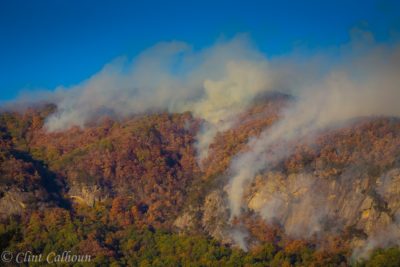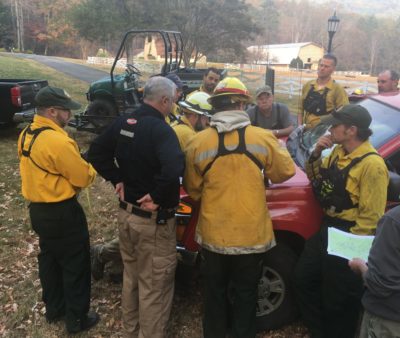The Party Rock Fire: What Happens Next?

When Chris “Shrimper” Khare saw orange and red flickering smoke, he knew it was time to evacuate. The reflecting flames signaled that the Party Rock Fire, about a quarter mile away, was getting too close for comfort.
Khare and his crew of six were camping on the slopes of Weed Patch Mountain, a summit just south of Rumbling Bald where the fire first ignited. Since April, his team has been digging Carolina Mountain Land Conservancy’s newest hiking and mountain biking trail. Winding seven miles through hemlocks, rhododendron and mountain laurel, the trail—being developed in partnership with the Town of Lake Lure—will soon connect the Town’s Buffalo Creek Park to Eagle Rock, a scenic promontory within Chimney Rock State Park. The project will be another segment of Carolina Mountain Land Conservancy’s budding public trail network in the Hickory Nut Gorge that one day may extend more than 50 miles connecting conserved lands.
“I’ve been building trails since 1989 and I’ve never seen anything like this,” shares Khare. “The smoke was always behind us so we could see the fire really well as it came around the ridge. As far away as it was and with the wind blowing against it the whole time, it just never seemed like it was going to get to us. We watched it for almost a week before we got too nervous that we had to get out.”
The crew hiked—saws and axes, McLeods and Pulaskis in tow—back to the parked truck a quarter mile away.
As the wildfire burned, large plumes of smoke scattered across the mountainside. Individual trees, mostly dead, burst into flame. Pockets rich with woody debris and leaf litter ignited causing abrupt, intense flares.
“I felt helpless in some ways, much the way someone would feel if their house was burning down,” says Clint Calhoun, Environmental Management Officer for the Town of Lake Lure. “The emotional side of me was concerned about the natural things that I care about. At the same time, I also had to reassure myself that fire, while not always caused by natural sources, is a natural part of the forest dynamic. Resolving that fact in my mind in the context of what was otherwise a very emotional event for our community, was therapeutic. At the same time my curiosity was at an all-time high, because I wanted to know how areas of the mountain were being impacted and what it would mean for the many natural communities on the mountain.”
After firefighters successfully contained the 7,141-acre wildfire, Khare and his trail building crew returned to work in early December. Their first task: removing fallen trees strewn across the trail.

“It was really amazing to see how hard the fire crews worked,” says Khare. “Where we access the trail, we go by a lot of structures that were on the front line and they didn’t let anything burn. They didn’t let people’s woodsheds burn.” To contain the fire, firefighters constructed more than 130,000 feet of fire line. Fire lines are made by cutting, scraping or digging into the soil, providing a gap in vegetation and other flammable material to slow or stop a wildfire’s progress.
Calhoun headed out to examine the aftermath. The charred ground served as a mat for the blackened bases of tree trunks. In several places, mountain laurel and rhododendron were virtually cooked. Some of the hemlocks burned from the inside out, leaving a hollowed portrait of a once towering tree. Many large trees were totally consumed by the wildfire; others were left unharmed.
While some of the aesthetic qualities of the Weed Patch Mountain Trail have been temporarily lost, there is a great deal of cautious optimism. “Next year in the heat, there will be better wind circulation and there will be some rejuvenation of plants that the rhododendrons choked out,” says Khare.
The question of all questions perhaps lingers in what sort of impact the Party Rock Fire will have on our natural resources, native plants and local wildlife. Because many decades have passed since a wildfire of this magnitude burned in the Hickory Nut Gorge, there is some uncertainty in what will grow back in these diverse natural areas.
“Theoretically speaking, the overall impact should be pretty positive,” says Calhoun. “We know that fire is a natural dynamic of forests; they are meant to burn as a way of reducing debris and litter and recycling carbon and other key elements back into the soil to encourage regrowth and regeneration.”
Wildfire increases biodiversity. It creates gaps in the forest that allow grasses and other plants to grow that are beneficial to wildlife, including insects, birds and small mammals, strengthening the overall food web. Wildfire plays a Darwinism-like role, removing diseased trees and shrubs, allowing for the growth of healthy ones, and providing the light needed for fire tolerant plants to thrive. Shrubs such as mountain laurel and rhododendron will be significantly reduced in size, and will have a more appropriately balanced presence in the forest.
“From a purely scientific standpoint, it’s an exciting event for me personally because this fire impacted several different ecological areas that will all respond in different ways,” says Calhoun. “The accessibility of many of these areas will make them interesting research subjects.”
One hundred eighty acres of Carolina Mountain Land Conservancy’s Teaching and Research Reserve, a project in partnership with the Community of the Transfiguration (a Religious Order for women in the Episcopal Church), burned. The property, located in Bat Cave, will provide a great opportunity for researchers to study the long-term effects of the fire.
“I think there is a lot we can learn about fire ecology in the Hickory Nut Gorge that we may have always suspected, but can now be proven or disproved,” says Calhoun.
The Weed Action Coalition of the Hickory Nut Gorge (WAC-HNG), a program of Carolina Mountain Land Conservancy composed of area partners, protects the natural environment of the Hickory Nut Gorge by managing the exotic invasive plants on public and private land. They operate collaboratively to provide landowners the information and resources they need to restore their land to its native habitat. WAC-HNG will be a major force in helping to mitigate the possible long-term effects of the Party Rock Fire.
“WAC-HNG is working with the North Carolina Forest Service to educate landowners in the Hickory Nut Gorge and is piloting a Citizen Scientist Program focused within the burn area to get the community outside and to help document the effects of the fire,” says David Lee, Natural Resource Manager at Carolina Mountain Land Conservancy. “We’re also continuing to work with public and private landowners to identify and control invasive plants, especially within the burned areas.”
“Generally, I feel like most people will see very little difference in the forest from a distant perspective,” shares Calhoun. “Up-close some differences may be quite considerable, but that may not be a bad thing.” The public will get an on-the-ground perspective of the post-fire landscape from the Weed Patch Mountain Trail once it opens this summer.
Katie Onheiber is communications and marketing manager with Carolina Mountain Land Conservancy.